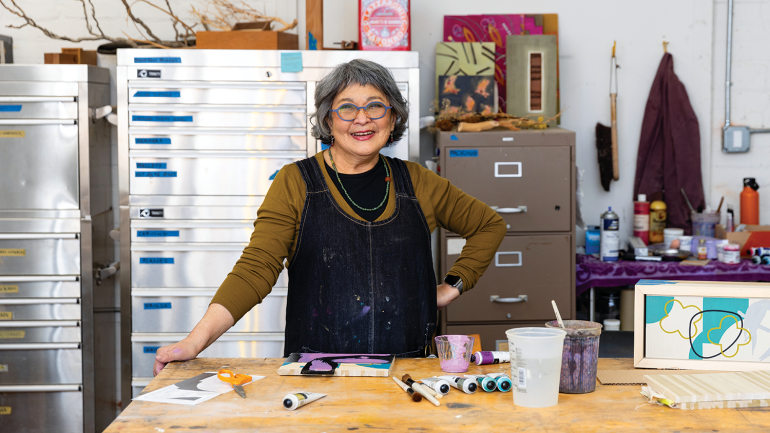Wendy Maruyama
Wendy Maruyama
Within the worlds of furniture art and craft, mere mention of Wendy Maruyama conjures images of sleek yet sumptuous wood tables, cabinets, and wall pieces merging curvilinear and rectilinear forms, while infused with vivid color, animated with carved treatments, and integrated with historic or fantastical imagery. The San Diego–based furniture artist has been called “a bit of a provocateur,” and her early work “playful” and “kicky.” Maruyama says she’s simply grateful “to work the way I do,” a sentiment more profound than it appears.
Born in La Junta, Colorado, to second-generation Japanese American parents, Maruyama was thrilled to discover art classes in elementary school. “Being deaf,” says the artist, who was also born with cerebral palsy, “I realized art was something I was really good at and felt confident doing.” In junior college, her first wood project was an epiphany: “I could be a woodworker,” she realized. “I was really intrigued with the idea of making one-of-a-kind furniture, and that was my beginning as a craftsperson.”
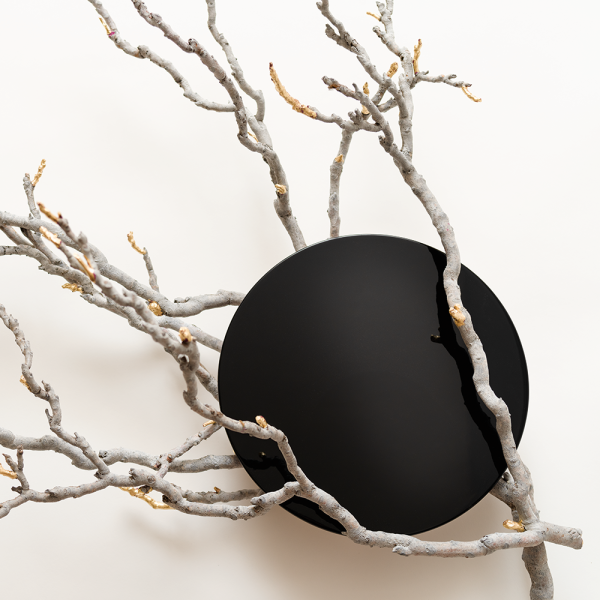
Wendy Maruyama’s Untitled, 2020, branches, gold leaf, black lacquer, 25 x 30 x 5 in. Photo courtesy of the artist.
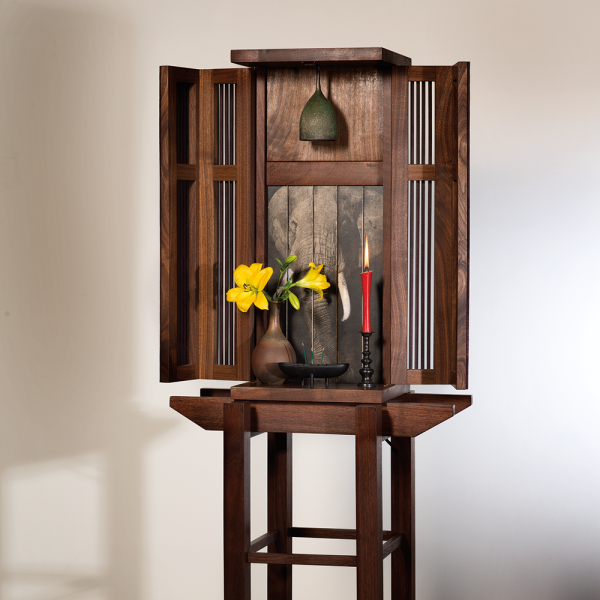
Bell Shrine, 2015, wood, bronze, ink, 65 x 16 x 12 in. Photo by Scott Cartwright and David Harrison.
Maruyama excelled in woodworking at San Diego State University, receiving her BA in 1975 while also studying with jewelry artist Arline Fisch (a 1979 ACC Fellow). In 1980, Maruyama was the second woman, and the first deaf student, to complete an MFA at the Rochester Institute of Technology’s School for American Crafts in New York. She was one of the first women in the field of studio furniture.
Today I’m going back . . . to what makes me joyful and happy.
Wendy Maruyama
Initially, Maruyama crafted 15 to 20 pieces a year that challenged woodworking’s masculine heritage and traditional expectations of furniture making with humor and social commentary, sculptural forms and color. Her 1982 Mickey Mackintosh chair, for instance, pays homage to Mickey Mouse and Scottish designers Charles Rennie Mackintosh and Margaret Macdonald Mackintosh. Her 1992 maple and mahogany chest Candy has surfboard-like wings and is painted cherry red.
Maruyama’s most recent work has boldly reflected her social consciousness and explored her heritage. In 2012, after several trips to Japan, she created Executive Order 9066 and The Tag Project in response to President Franklin Roosevelt’s internment of American citizens and resident aliens of Japanese ancestry in 1942. The first piece includes wall-mounted cabinets, reliquary formats, and sculptures enshrining elements from the internment camps (tar paper, barbed wire, painted rice bowls) and images based on documentary photographs by Dorothea Lange and Toyo Miyatake. The Tag Project consists of 120,000 replicas of paper internee identification tags suspended from the ceiling in 10 bundles.
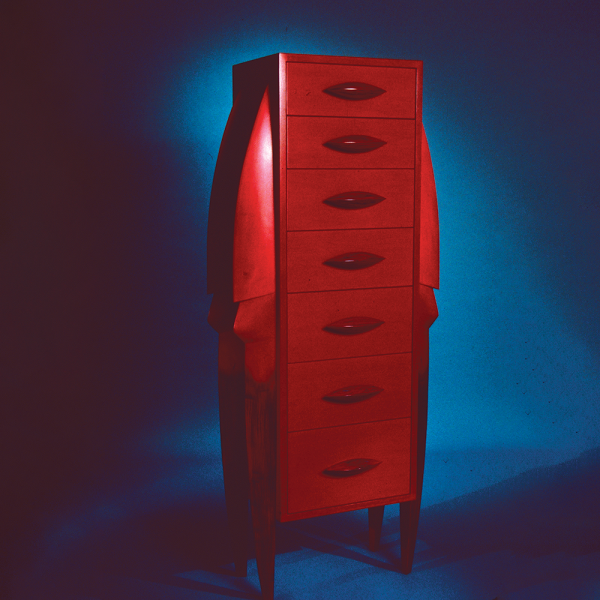
Candy, 1992, wood, 55 x 25 x 12 in. Photos courtesy of the artist.
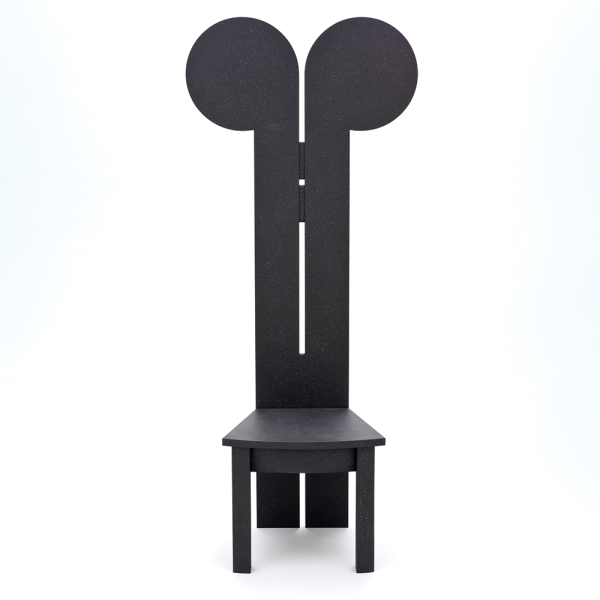
Designed in 1981, this Mickey Mackintosh chair is one of 25 Maruyama built from poplar and zolatone paint, 60 x 33 x 18 in. Photo courtesy of the artist.
Maruyama’s 2015 wildLIFE Project was inspired by trips to Kenya, where she learned about animal poaching (particularly elephants), and by her residency at the Pilchuck Glass School (her blown-glass tusks became part of her 2015 work Sarcophagus). WildLIFE consists of six life-sized elephant heads constructed of stitched, painted-wood segments, and a Buddhist-style Bell Shrine with burning incense and a bronze bell that rings every 15 minutes in memory of elephants killed for their tusks.
All the while, Maruyama—who was inducted into the College of Fellows in 2008—has influenced younger makers. From 1980 to 1985 she taught at the Appalachian Center for Craft. She was also a professor of woodworking and furniture design at the California College of Arts and Crafts in Oakland, and at San Diego State University (where she’s now professor emerita). Maruyama received several grants from the National Endowment for the Arts as well as numerous fellowships and awards while lecturing and exhibiting around the world. She has served on panels, juries, advisory boards, and boards of trustees for a diversity of craft organizations.
“Today,” Maruyama says, “I’m moving away from all of that serious work and going back to furniture-like pieces, to what makes me joyful and happy.”
Read more about the other 2024 ACC Awards recipients and honorees here.
Be part of the celebration
Join us Thursday, September 19 as we celebrate and honor individuals who have dedicated their careers to craft, and who—through their work as artists, educators, mentors, curators, and advocates—have inspired and informed the field.
